Shear Capacity and Behaviour of Bending Reinforced Concrete Beams Made of Steel Fibre-Reinforced Waste Sand Concrete
Abstract
:1. Introduction
2. Test Materials
3. Methodology of Research and Test Elements
4. Test Results and Their Analysis
4.1. Shear Behaviour of Bending Infibre-Reinforced Concrete Beams
4.2. Beam Failure Models and Experimentally Determined Shear Capacity
4.3. Diagonal Cracks
5. Computational Analysis
6. Conclusions
- (1).
- The fine aggregate concrete composite without steel fibres behaves like ordinary concrete, as a typical flexural element with conventional steel rebars. The computation results for the shear capacity of such elements using the RILEM and Model Code 2010 methods are fully satisfactory.
- (2).
- According to the ultimate limit stage of shear capacity, fibre reinforcement in SFRWSC beams considerably contributes to the resistance of shearing forces and increases the shearing capacity (amounting to approximately 80%, compared to elements without shear reinforcement).
- (3).
- The functional character of steel fibres in the shear area is better than that of stirrups, due to their more ductile material character. This conclusion was confirmed by the dependence of the transversal force (V) on deformations (ε), determined at the side beam surface at its height. The effects of steel fibres and stirrups add up, in terms of resistance to transversal forces, both in the aspect of increasing the shear capacity, as well the element deformability.
- (4).
- Steel fibres at an amount of 1.2% in SFRWSC affect the occurrence of diagonal cracks. Diagonal cracks in beams with fibres appeared at higher transversal force values than in the case of elements without fibres. The diagonal crack analysis showed that the shear crack force was approximately 57% of the ultimate shear force. Thus, the steel fibres contribute not only to increasing the shear capacity, but also to the increase inthe shear crack force.
- (5).
- The addition of 1.2% steel fibres considerably improves the shear capacity of SFRWSC elements. This allows for the reduction of conventional reinforcement in such elements. Due to the high residual tensile strength (fFtu) of fibre-reinforced concrete, the analysed SFRWSC does not require minimum reinforcement in the form of stirrups, as indicated by the following formula:
- (6).
- With regard to elements made of SFRWSC, the shear capacity values computed using the RILEM and Model Code 2010 methods were higher than the experimentally determined values. The obtained results indicate a necessity for correction of these methods, in order to apply them to the shear design of elements made of SFRWSC. Other researches who have been working on classical fibre-reinforced concrete have arrived at similar conclusions. Furthermore, the computation procedure using the minimum angle of inclination of compression struts, according to the SMCFT method, in terms of the tested fibre-reinforced composite, requires correction, due to great differences between the measured and computed angle values. What the authors consider as the further direction of research and analysis.
- (7).
- Considering the mechano-physical properties of SFRWSC and the shear capacity test results presented in this paper, as well as the flexural capacity values for beams made of this fibre-reinforced composite, as described in [15,36], the assumption can be made that this material can successfully be used as a structural material. The developed SFRWSC, the properties of which comply with the requirements set for structural materials, could be used as an alternative solution for ordinary concrete in some applications, providing an opportunity to utilise the waste sands piled in Pomerania (Poland), in the Middle East, or in North Africa.
Author Contributions
Funding
Institutional Review Board Statement
Informed Consent Statement
Data Availability Statement
Conflicts of Interest
Nomenclature
| CMOD | Crack Mouth Opening Displacement |
| SFRWSC | Steel Fibre Reinforced Waste Sand Concrete |
| SMCFT | Simplified Modified Compression Field Theory |
| Ecm | static modulus of elasticity |
| Ed | dynamic modulus of elasticity |
| Es | modulus of elasticity of longitudinal steel rebars |
| Gd | dynamic modulus of rigidity |
| Vcr | shear crack force |
| Vcal | calculated shear capacity |
| Vexp | experimental shear capacity |
| VRd | shear capacity |
| VRd,c | specimen’s shear capacity without shear reinforcement |
| VRd,s | shear capacity increase due to conventional shear reinforcement |
| Vult | ultimate shear force |
| δ | deflection |
| εy | mean value of strain |
| θ | compression strut angle |
| ν | coefficient of variation |
| a | shear span, |
| d | effective depth of beam |
| fc,f | fibre-reinforced composite compression strength |
| fc | fibre-less composite compression strength |
| fct | fibre-less composite tensile strength |
| fFtu | residual tensile strength of fibre-reinforced concrete defined for wu = 1.5 mm |
| fR,1 fR,2 fR,3 fR,4 | residual strengths determined in accordance with relevant standard for CMOD = 0.5 mm, 1.5 mm, 2.5 mm, and 3.5 mm |
| fy | longitudinal reinforcement steel yielding strength |
| fyw | shear reinforcement (stirrups) steel yielding strength |
| ft,spl | split tensile strength |
| ft | tensile strength of longitudinal steel rebars |
| ftw | tensile strength of shear reinforcement (stirrups) |
| s | standard deviation |
| w | crack width |
References
- Yazici, S.; Inan, G.; Tabak, V. Effect of aspect ratio and volume fraction of steel fiber on the mechanical properties of SFRC. Constr. Build. Mater. 2007, 21, 1250–1253. [Google Scholar] [CrossRef]
- Teng, T.-L.; Chu, Y.A.; Chang, F.A.; Shen, B.-C.; Cheng, D.-S. Development and validation of numerical model of steel fiberreinforced concrete for high-velocity impact. Comput. Mater. Sci. 2008, 42, 90–99. [Google Scholar] [CrossRef]
- Wang, Z.; Liu, Y.-S.; Shen, R.F. Stress–strain relationship of steel fiber-reinforced concrete under dynamic compression. Constr. Build. Mater. 2008, 22, 811–819. [Google Scholar] [CrossRef]
- Hu, H.; Papastergiou, P.; Angelakopoulos, H.; Guadagnini, M.; Pilakoutas, K. MechanicalpropertiesofSFRCusingblendedmanufacturedandrecycledtyresteelfibres. Constr. Build. Mater. 2018, 163, 376–389. [Google Scholar] [CrossRef]
- Ibrahim, S.M.; Abadel, A.A.; Almusallam, T.; Al-Salloum, Y. Modeling of steel fiber reinforced concrete (SFRC) under dynamic compression. In Proceedings of the Conference: 8th International Conference FIBRE CONCRETE 2015, Prague, Czech Republic, 10–11 September 2015. [Google Scholar]
- Li, C.; Zhao, M.; Zhang, X.; Li, J.; Li, X.; Zhao, M. Effect of Steel Fiber Content on Shear Behavior of Reinforced Expanded-Shale Lightweight Concrete Beams with Stirrups. Materials 2021, 14, 1107. [Google Scholar] [CrossRef] [PubMed]
- Lim, S.; Matsuda, M.; Ahmed Raju, R.; Akiyama, M. Flexural Behavior Prediction of SFRC Beams using Finite Element Method and X-ray Image. Trans. Jpn. Concr. Inst. 2020, 39, 1099–1104. [Google Scholar]
- Goremikins, V.; Blesak, L.; Novak, J.; Wald, F.A.E. Experimental investigation on SFRC behaviour under elevated temperature. J. Struct. Fire Eng. 2017, 8, 287–299. [Google Scholar] [CrossRef]
- Domski, J.; Zakrzewski, M. Deflection of steel fiber reinforced concrete beams based on waste sand. Materials 2020, 13, 392. [Google Scholar] [CrossRef] [Green Version]
- Dupont, D.; Vandewalle, L. Distribution of steel fibres in rectangular sections. Cem. Concr. Compos. 2004, 27, 391–398. [Google Scholar] [CrossRef]
- Głodkowska, W.; Kobaka, J. Modelling of properties and distribution of steel fibres within a fine aggregate concrete. Constr. Build. Mater. 2013, 44, 645–653. [Google Scholar] [CrossRef]
- Głodkowska, W. Waste Sand Fiber Composite: Models of Description of Properties and Application. Annu. Set Environ. Prot. 2018, 20, 291. [Google Scholar]
- Głodkowska, W.; Laskowska-Bury, J. Waste Sands as a Valuable Aggregates to Produce Fibrecomposites. Annu. Set Environ. Prot. 2015, 17, 507–525. [Google Scholar]
- Głodkowska, W.; Kobaka, J. Estimating the properties of a fine aggregate fibre reinforced cementitious composite using non-destructive methods. J. Civ. Eng. Manag. 2018, 24, 630–637. [Google Scholar] [CrossRef]
- Głodkowska, W.; Ziarkiewicz, M. Cracking behavior of Steel Fiber Reinforced Waste Sand Concrete beams in flexure—experimental investigation and theoretical analysis. Eng. Struct. 2018, 176, 1–10. [Google Scholar] [CrossRef]
- Test Method for Metallic Fibered Concrete—Measuring the Flexural Tensile Strenght (Limit of Proportionality (LOP), Residual); PN-EN14651; BSI: London, UK, 2005.
- Model Code 2010. In Final draft, fib Bulletin 66, v. 2, 2012; Comité Euro-International du Béton—Fédération International e de la Précontrainte: Paris, France, 2010.
- Batson, G.; Jenkins, E.; Spaney, R. Steel Fibers as Shear Reinforcement Beams. ACI J. 1972, 69, 640–644. [Google Scholar]
- Sharma, A.K. Shear Strength of Steel Fiber Reinforced Concrete Beams. ACI J. 1986, 83, 624–628. [Google Scholar]
- Narayanan, R.; Darwish, I.Y.S. Use of Steel Fibres as Shear Reinforcement. ACI J. 1987, 84, 216–227. [Google Scholar]
- You, Z.; Jalai, S.; Ding, Y. The composite effect of steel fibres and stirups on shear behaviour of beams using selfconsolidating concrete. Eng. Struct. 2011, 33, 107–117. [Google Scholar]
- Ding, Y.; Yulin, Z.; Ning, X.; Azevedo, C. Shear resistance and cracking behaviour of SFRC beams with and without axial load. Mag. Concr. Res. 2014, 23, 1183–1193. [Google Scholar] [CrossRef] [Green Version]
- Zhao, J.; Liang, J.; Chu, L.; Shen, F. Experimental Study on Shear Behavior of Steel Fiber Reinforced Concrete Beams with High-Strength Reinforcement. Materials 2018, 11, 1682. [Google Scholar] [CrossRef] [Green Version]
- Minelli, F.; Conforti, A.; Cuenca, E.; Plizzari, G. Are steel fibres able to mitigate or eliminate size effect in shear? Mater. Struct. 2014, 47, 459–473. [Google Scholar] [CrossRef]
- Cuenca, E.; Conforti, A.; Minelli, F.; Plizzarii, G.A. A material-performance-based database for FRC and RC elements under shear loading. Mater. Struct. 2018, 51, 11. [Google Scholar] [CrossRef]
- Lantsoght, E.O.L. Database of Shear Experiments on Steel Fiber Reinforced Concrete Beams without Stirrups. Materials 2019, 12, 917. [Google Scholar] [CrossRef] [PubMed] [Green Version]
- Valikhani, A.; Jaberi Jahromi, A.; Mantawy, I.M.; Azizinamini, A. Numerical Modelling of Concrete-to-UHPC Bond Strength. Materials 2020, 13, 1379. [Google Scholar] [CrossRef] [Green Version]
- Tamayo, J.L.P.; Awruch, A.M.; Morsch, I.B. Numerical modeling of reinforced concrete structures: Static and dynamic analysis. Rem. Rev. Esc. Minas 2013, 66, 425–430. [Google Scholar] [CrossRef] [Green Version]
- Dashti, F.; Dhakal, R.P.; Pampanin, S. Numerical Modeling of Rectangular Reinforced Concrete Structural Walls. J. Struct. Eng. 2017, 143, 6. [Google Scholar] [CrossRef]
- Głodkowska, W.; Ruchwa, M. Static analysis of reinforced concrete beams strengthened with CFRP composites, Arch. Civ. Eng. 2010, 56, 111–122. [Google Scholar]
- Sucharda, O. Identification of Fracture Mechanic Properties of Concrete and Analysis of Shear Capacity of Reinforced Concrete Beams without Transverse Reinforcement. Materials 2020, 13, 2788. [Google Scholar] [CrossRef] [PubMed]
- Budarin, A.; Alekhin, V.; Avdonina, L. Numerical modelling of the reinforced concrete beam shear failure. IOP Conf. Ser. Mater. Sci. Eng. 2019, 687, 033044. [Google Scholar] [CrossRef]
- Talavera-Sánchez, S.; Navarro-Gregori, J.; Ortiz-Navas, F.; Serna, P. Numerical Modelling of Fiber-Reinforced Concrete Shear-Critical Beams, Fibre Reinforced Concrete: Improvements and Innovations. RILEM 2021, 30, 670–680. [Google Scholar]
- Amin, A.; Foster, S.J. Numerical modelling of large scale steel fibre reinforced-reinforced concrete beams failing in shear. In Fib Bulletin 79. Fibre-Reinforced Concrete: From Design to Structural Applications; University of New South Wales: Sydney, Australia, 2017. [Google Scholar]
- Barros, J.; Sanz, B.; Kabele, P.; Yu, R.C.; Meschke, G.; Planas, J.; Cunha, V.; Caggiano, A.; Ozyurt, N.; Gouveia, V.; et al. Blind competition on the numerical simulation of steel-fiber-reinforced concrete beams failing in shear. Struct. Concr. 2021, 22, 939–967. [Google Scholar] [CrossRef]
- Głodkowska, W.; Ziarkiewicz, M. Estimation of Load Bearing Capacity of Bending Fibrocomposite Elements. Annu. Set Environ. Prot. 2019, 21, 294–315. [Google Scholar]
- Beňoa, J.; Hilara, M. Steel fibre reinforced concrete for tunnel lining—verification by extensive laboratory testing and numerical modelling. Acta Polytech. 2013, 53, 329–337. [Google Scholar]
- Foster, S.J.; Agarwal, A.; Amin, A. Design of steel fiber reinforced concrete beams for shear using inverse analysis for determination of residual tensile strength. Struct. Concr. 2018, 19, 129–140. [Google Scholar] [CrossRef]
- RILEMTC162-TDF. Test and design methods for steel fibre reinforced concrete. Mater. Struct. 2003, 36, 560–567. [Google Scholar] [CrossRef]
- Amin, A.; Foster, S.J. Shear strength of steel fibre reinforced concrete beams with stirrups. Eng. Struct. 2016, 111, 323–332. [Google Scholar] [CrossRef]
- Parmentier, B.; Cauberg, N.; Vandewalle, L. Shear Resistance of Macro-Synthetic and Steel Fibre Reinorced Concrete Beams without Stirrups. In Proceedings of the 8th RILEM International Symposium on Fibre Reinforced Concrete: Challenges and Opportunities, Guimaraes, Portugal, 19–21 September 2012; pp. 1096–1108. [Google Scholar]
- Araújo, D.L.; Nunes, F.G.T.; Filho, R.D.T.; de Andrade, M.A.S. Shear strength of steel fiber-reinforced concrete beams. Acta Scientiarum. Technol. 2014, 36, 389–397. [Google Scholar] [CrossRef]
- Bernat, A.M.; Spinella, N.; Recupero, A.; Cladera, A. Mechanical model for the shear strength of steel fiber reinforced concrete (SFRC) beams without stirrups. Mater. Struct. 2020, 53, 28. [Google Scholar] [CrossRef]
- Lehmann, M. Shear capacity of Steel Fiber Reinforced Waste Sand Concrete Beams. Ph.D. Thesis, Koszalin University, Koszalin, Poland, June 2020. [Google Scholar]
- Meyer, C. The greening of the concrete industry. Cem. Concr. Compos. 2009, 31, 601–605. [Google Scholar] [CrossRef]
- Hendriks, C.; Janssen, G. Use of recycled materials in construction. Mater. Struct. 2003, 36, 604–608. [Google Scholar] [CrossRef]
- Siddique, R. Waste Materials and By-Products in Concrete; Springer: Berlin/Heidelberg, Germany, 2008; pp. 381–405. [Google Scholar]
- Soares, D.; de Brito, J.; Ferreira, J.; Pacheco, J. In situ materials characterization of full-scale recycled aggregates concrete structures. Constr. Build. Mater. 2014, 71, 237–245. [Google Scholar] [CrossRef]
- Ulsen, C.; Kahn, H.; Hawlitschek, G.; Masini, E.A.; Angulo, S.C. Separability studies of construction and demolition waste recycled sand. Waste Manag. 2013, 33, 656–662. [Google Scholar] [CrossRef]
- Al-Harthy, A.S.; Abdel Halim, M.; Taha, R.; Al-Jabri, K.S. The properties of concrete made with fine dune sand. Constr. Build. Mater. 2007, 21, 1803–1808. [Google Scholar] [CrossRef]
- Głodkowska, W.; Kobaka, J. Application of waste sands for making industrial floors. Annu. Set Environ. Prot. 2009, 11, 193–206. [Google Scholar]
- Domski, J.; Głodkowska, W. Selected Mechanical Properties Analysis of Composites Made on the Basis Fine Waste Aggregate. Annu. Set Environ. Prot. 2017, 19, 81–95. [Google Scholar]
- PN-EN12620+A1:2010. Aggregates for Concrete; Polish Committee for Standardization: Warsaw, Poland, 2009. [Google Scholar]
- Cartuxo, F.; de Brito, J.; Evangelista, L.; Jiménez, J.R.; Ledesma, E.F. Rheological behavior of concrete made with finerecycled concrete aggregates—Influence of the super plasticizer. Constr. Build. Mater. 2015, 89, 36–47. [Google Scholar] [CrossRef]
- Declaration of Performance, No.2/2013/E—EKOMENT Steel Fibres 50 × 0.8 mm, (Polish Declaration of Performance). Available online: http://ekomet-ozorkow.com.pl/en/146-2/ (accessed on 16 July 2013).
- Technical approval of the Institute of Building Technology No.AT-15-2095/1999, Steel fibers 50 × 1.0 mm, 50 × 0.8 mm, 50 × 0.65 mm, 60 × 0.8 mm and 30 × 0.65 mm for concrete reinforcement (Polish Technical Approval). Available online: https://www.itb.pl/en/ (accessed on 16 July 1999).
- PN-EN 14889-1. Fibresfor Concrete. Steel Fibres. Definitions, Specifications and Conformity; Polish Committee for Standardization: Warsaw, Poland, 2007. [Google Scholar]
- Domski, J. Ablurred border between ordinary concrete and SFRC. Constr. Build. Mater. 2016, 112, 247–252. [Google Scholar] [CrossRef]
- Głodkowska, W.; Lehmann, M. Shear Capacity and Residual Strengths of Steel Fibre Reinforced Waste Sand Concrete (SFRWSC). Annu. Set Environ. Prot. 2019, 21, 1405–1426. [Google Scholar]
- PN-EN12390-7:2009. Testing Hardened Concrete. Density of Hardened Concrete; Polish Committee for Standardization: Warsaw, Poland, 2009. [Google Scholar]
- PN-EN 12390-3: 2019-07. Testing Hardened Concrete—Part 3: Compressive Strength of Test Specimens; Polish Committee for Standardization: Warsaw, Poland, 2019. [Google Scholar]
- PN-EN 12390-6:2011. Testing Hardened Concrete. Tensile Splitting Strength of Test Specimens; Polish Committee for Standardization: Warsaw, Poland, 2011. [Google Scholar]
- PN-EN 12390- 13: 2014-02. Testing Hardened Concrete. Determination of Secant Modulus of Elasticity in Compression; Polish Committee for Standardization: Warsaw, Poland, 2014. [Google Scholar]
- Neville, A.M. Properties of Concrete; Arkady: Kraków, Poland, 2000; pp. 427–436. [Google Scholar]
- Instruction ITB194/98. Tests of Mechanical Properties of Concrete on Elements Made in Forms; Building Research Institute: Warsaw, Poland, 1998. [Google Scholar]
- PN-EN 13892-3:2005-02. Methods of Test for Screed Materials. Determination of Wear Resistance. In Böhme; Polish Committee for Standardization: Warsaw, Poland, 2005. [Google Scholar]
- JCI-SF6:1984. Method of test for shear strength of fiber reinforced concrete. In JCI Standard for Test Methods of Fiber Reinforced Concrete; JCI: Tokyo, Japan, 1983; pp. 57–59. [Google Scholar]
- Glinicki, M.A.; Litorowicz, A.; Zieliński, M. Interpretation of the test sof resistance of FRC to cracking in bending. In Proceedings of the Scientific Conference KILiW PAN i KN PZITB, Krynica, Poland, 16–21 September 2001. (Polish Standard). [Google Scholar]
- Minelli, F.; Plizzari, G.A. Fiber reinforced concrete characterization through round panel test—part I: Experimental study. Fract. Mech. Concr. Concr. Struct. 2010, 7, 1451–1460. [Google Scholar]
- Godycki-Ćwirko,T. Concrete Mechanics; Arkady: Kraków, Poland, 1982; (Polishbook). [Google Scholar]
- Yoo, D.Y.; Yang, J.M. Effects of stirrup, steel fiber, and beam size on shear behavior of high-strength concrete beams. Cem. Concr. Compos. 2018, 87, 137–148. [Google Scholar] [CrossRef]
- Ashour, S.A. Effect of compressive strength and tensile reinforcement ratio on flexural behavior of high-strength concrete beams. Eng. Struct. 2000, 22, 413–423. [Google Scholar] [CrossRef]
- Subramaniam, K.V.L.; Gali, S. Shear behaviour of Steel Fiber Reinforced Concrete using full-field displacement from digital image corelation. MATEC Web Conf. 2017, 120, 1–13. [Google Scholar]
- Lim, D.H.; Oh, B.H. Experimental and Teoretical Investigation on the Shear of Steel Fibre. Eng. Struct. 1999, 21, 937–944. [Google Scholar] [CrossRef]
- Amin, A.; Foster, S.J.; Muttoni, A. Derivation of the σ-w relationship for SFRC from prism bending tests. Struct. Concr. 2015, 16, 93–105. [Google Scholar] [CrossRef] [Green Version]
- Baghi, H.; Barros, J.A.O. Design-oriented approach to predict shear strength of reinforced concrete beams. Struct. Concr. 2018, 19, 98–115. [Google Scholar] [CrossRef] [Green Version]
- PN-EN 1992 -1-1:2008. Eurocode 2: Design of Concrete Structures—Part 1-1: General Rules and Rules for Buildings; Committee for Standardization: Warsaw, Poland, 2008. [Google Scholar]
- Matthys, S.; Soetens, T. Engineering Model for SFRC Shear Strength Based on MC2010 Approach. In Proceedings of the High Tech Concrete: Where Technology and Engineering Meet, Maastricht, The Netherlands, 12–14 June 2017; pp. 374–381. [Google Scholar]
- Arslan, G. Shear Strength of Steel Fiber Reinforced Concrete (SFRC) Slender Beams. J. Civ. Eng. 2014, 18, 587–594. [Google Scholar] [CrossRef]
- Arslan, G.; Keskin, R.S.O.; Ulusoy, S. An Experimental Sudy on the Shear Strength of SFRC Beams without Stirrups. J. Theor. Appl. Mech. 2017, 55, 1205–1217. [Google Scholar] [CrossRef] [Green Version]
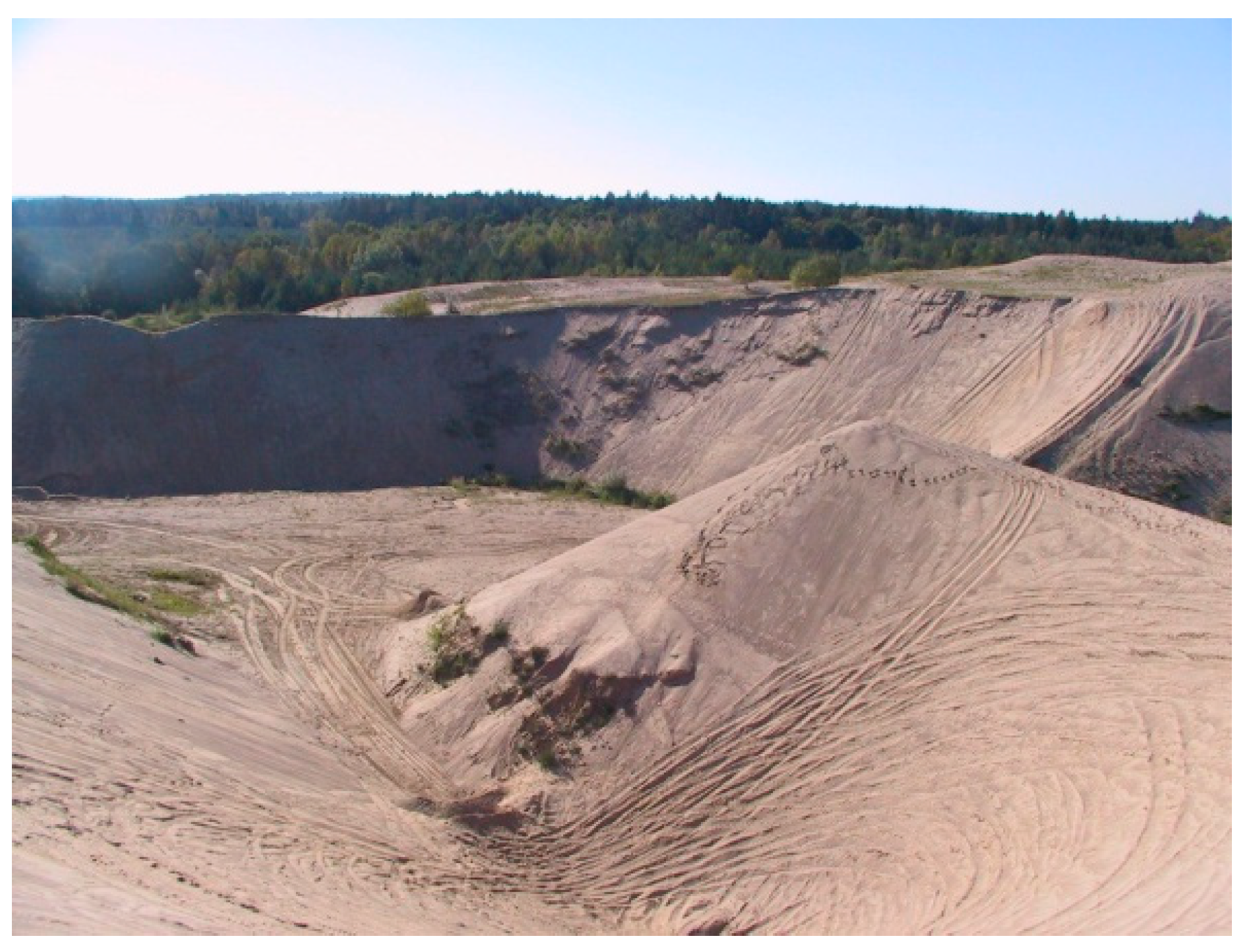


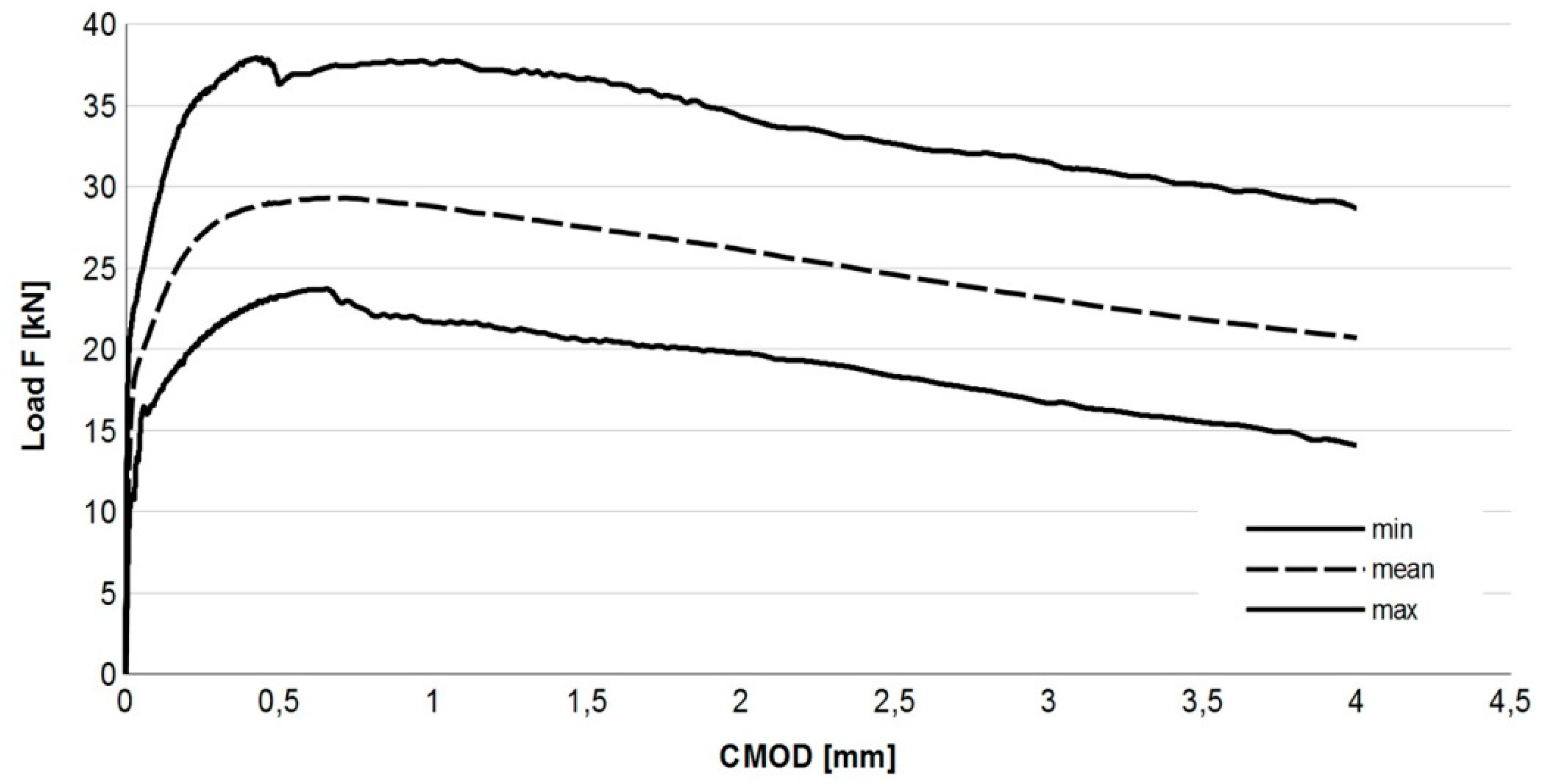


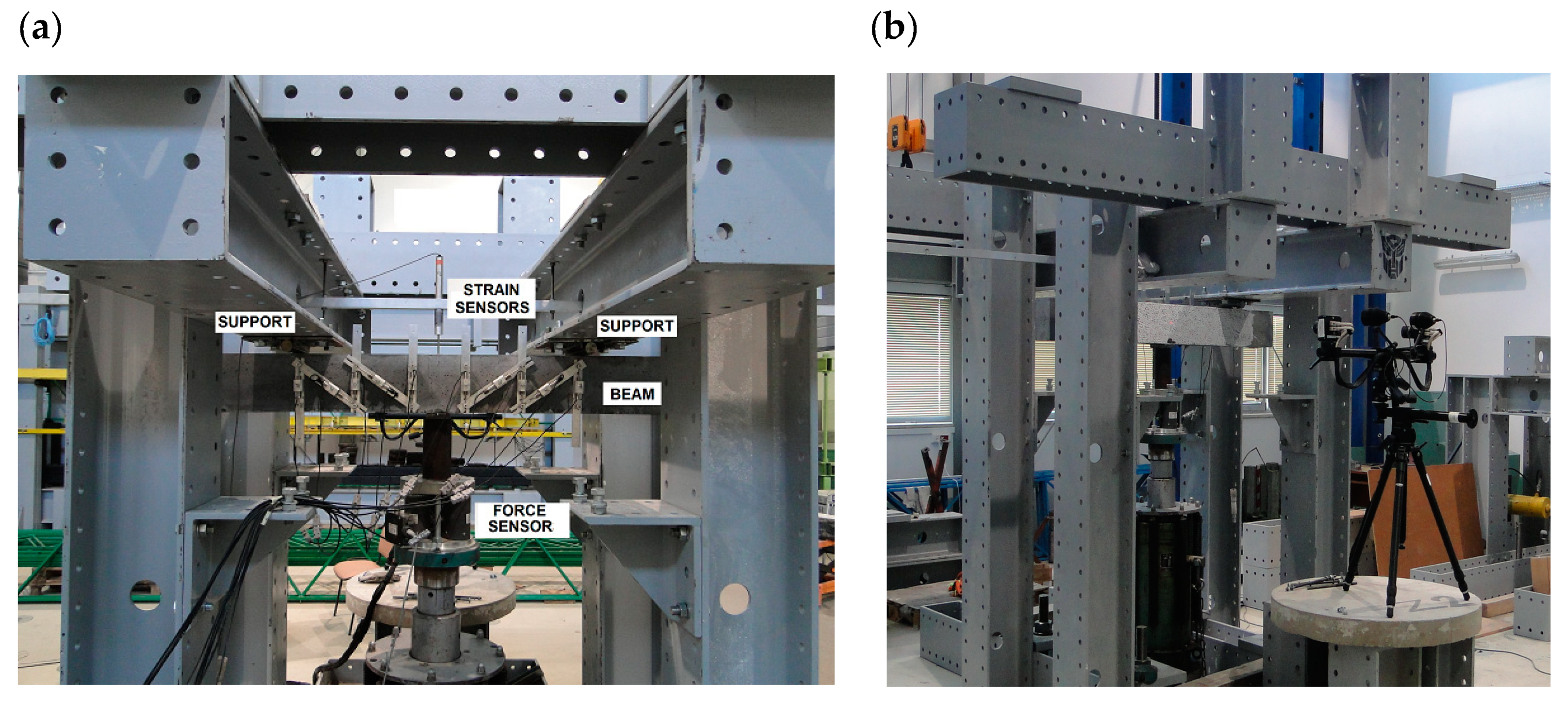
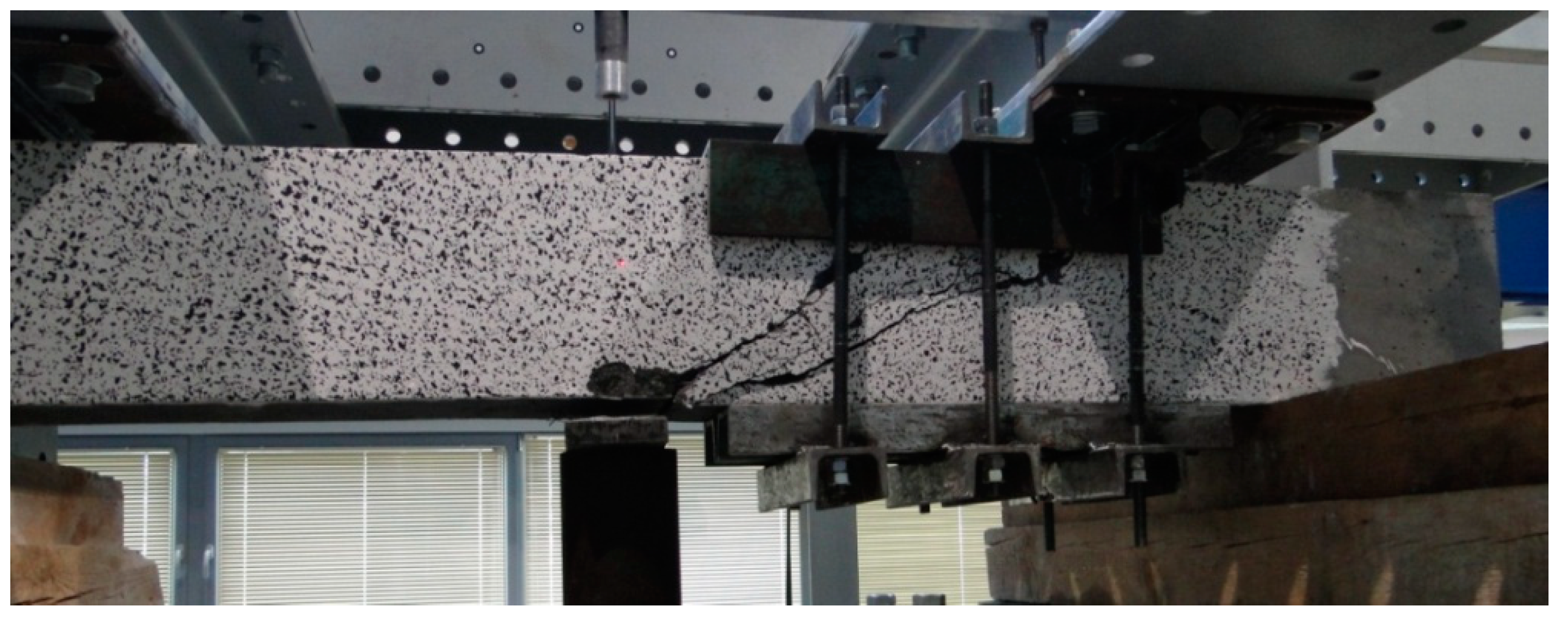








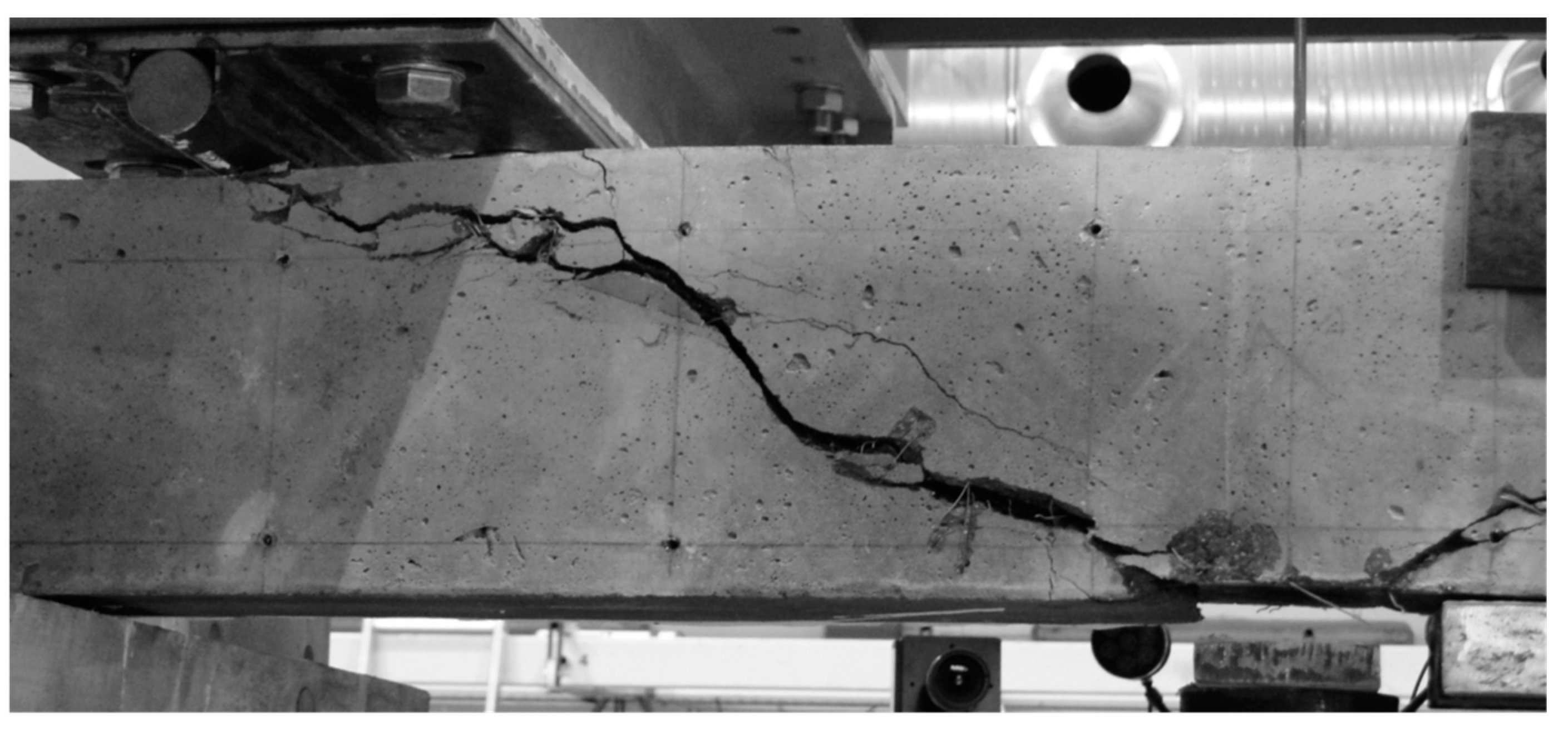
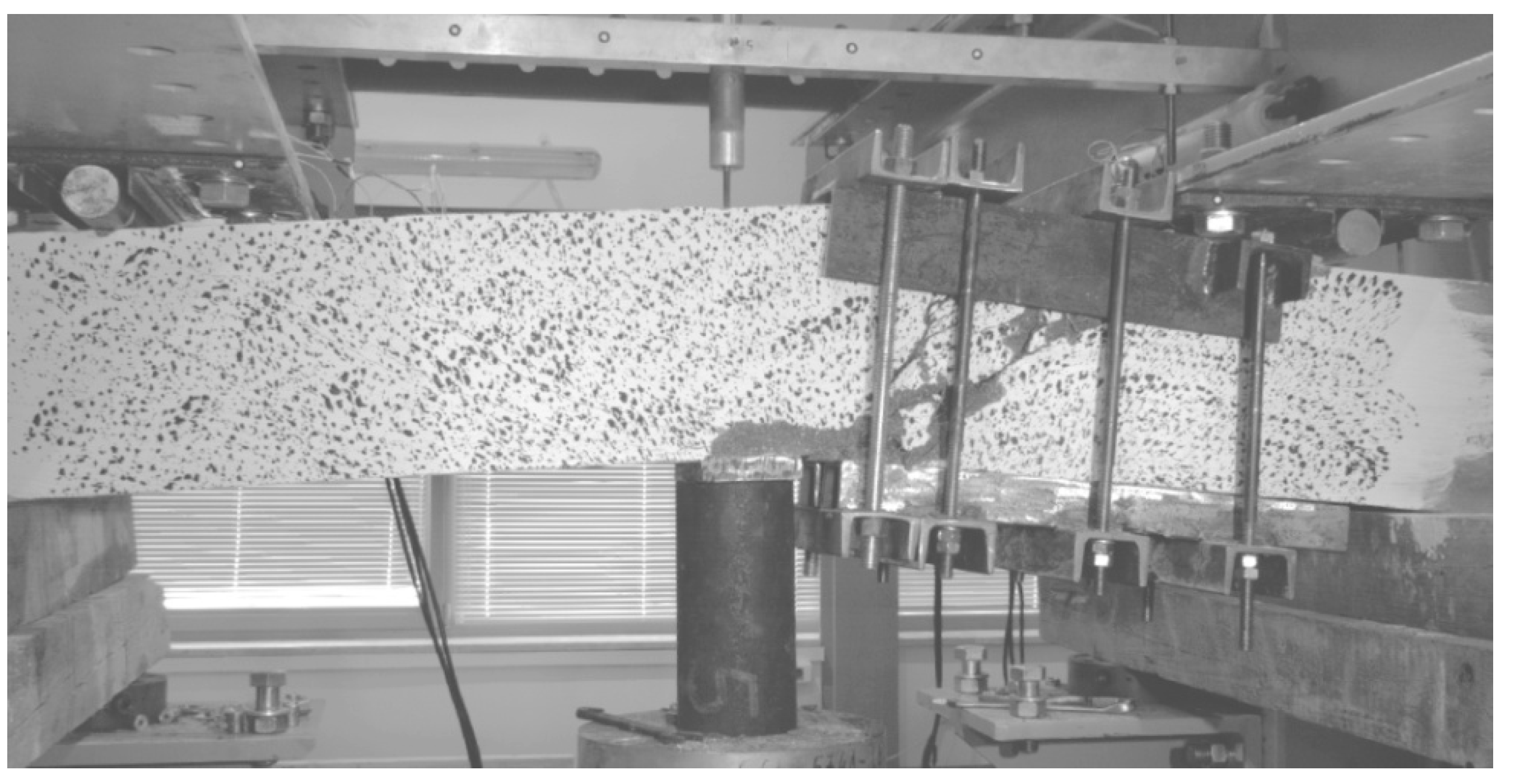



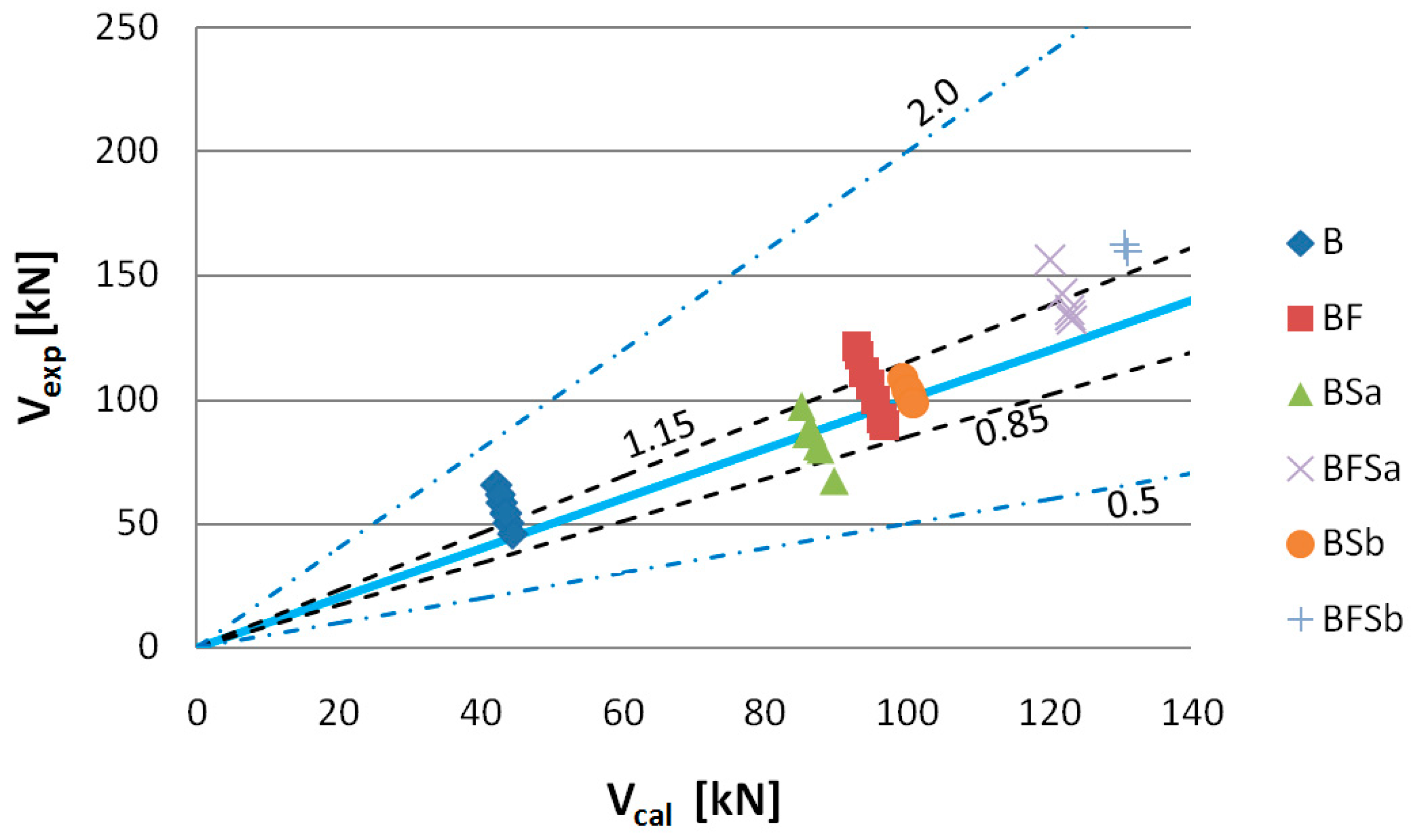

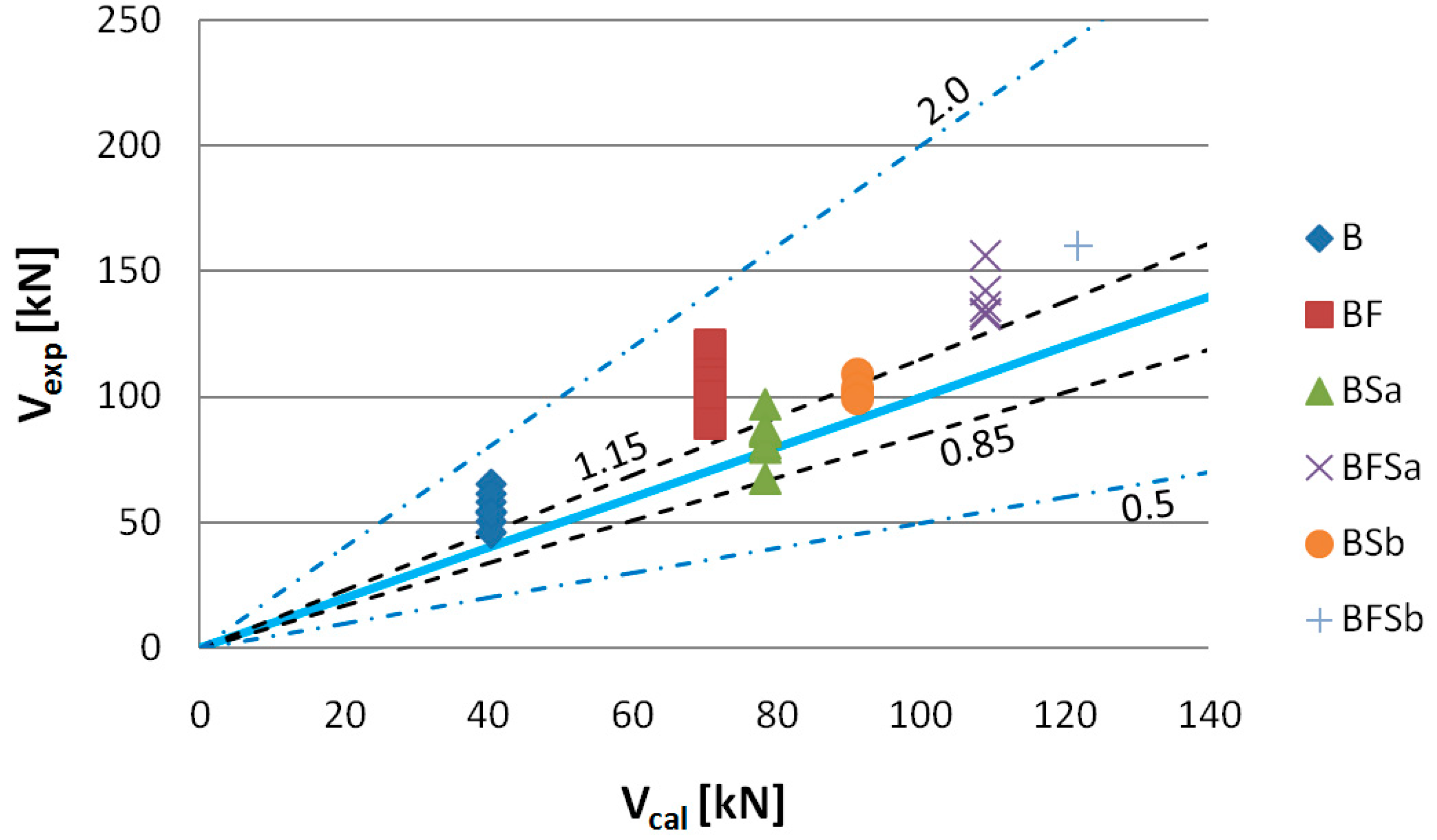


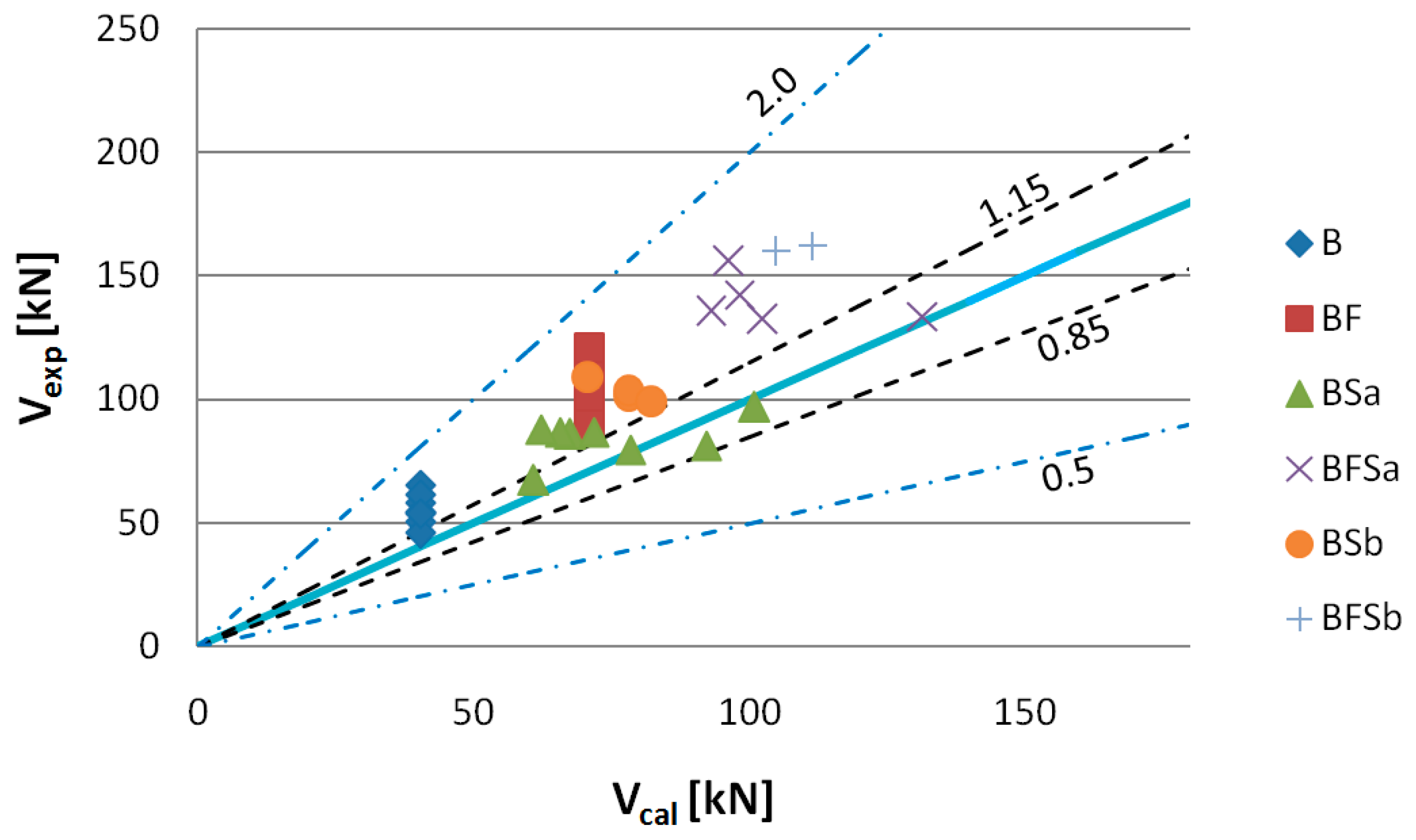
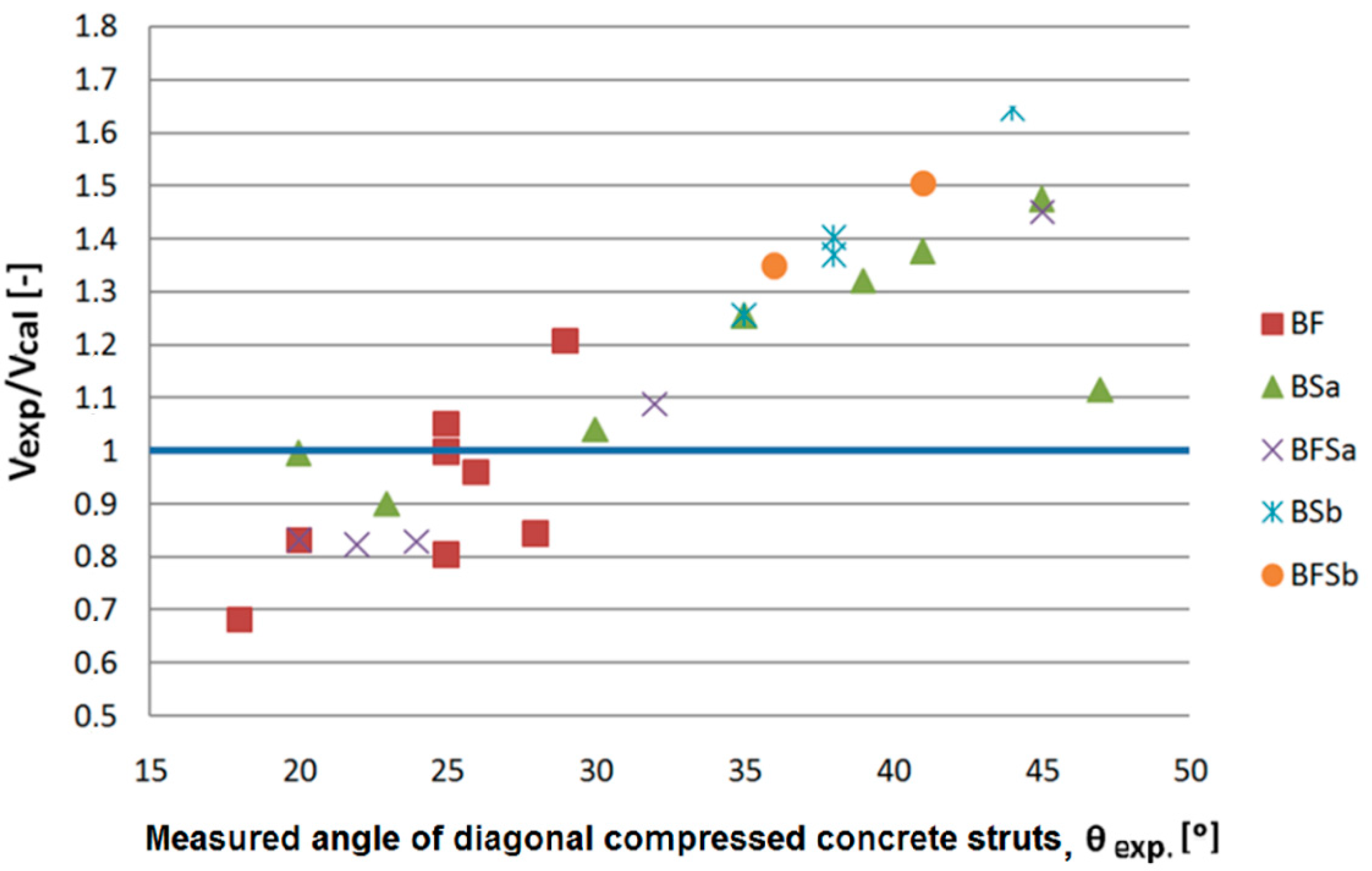
| Pos. | Feature | Value | UoM |
|---|---|---|---|
| 1 | Structural group | I | - |
| 2 | Tensile strength | 1160 ± 7 | N/mm2 |
| 3 | Young’s modulus | 210,000 | N/mm2 |
| 4 | Consistency by fibre content 14–15 kg/m3, measured by application of Ve-be method | 4 | s |
| 5 | Impact on concrete strength at CMOD * = 0.5 mm | 1.5 | N/mm2 |
| 6 | Impact on concrete strength at CMOD * = 3.5 mm | 1.0 | N/mm2 |
| Property | Material | Methodology of Determination | |
|---|---|---|---|
| Fibrecomposite (with Coefficient of Variation) | Ordinaryconcrete | ||
| Aparent density in dry condition: , [kg/m3]: | 2290 (ν = 0.7%) | 2000–2600 | PN-EN 12390-7 [60] |
| Compression strength: [MPa] | 64.4 (ν = 6%) | 12–50 (PN-EN 1992-1-1) | PN-EN 12390-3 [61] |
| Compression strength: [MPa] | 67.6 (ν = 3%) | 15–60 (PN-EN 1992-1-1) | |
| Split tensile strength: [MPa] | 7.3 (ν = 8%) | 3.0–3.7 | PN-EN 12390-6 [62] |
| Static modulus of elasticity: [GPa] | 36.7 (ν = 7%) | 29–37 | PN-EN 12390-13 [63] |
| Dynamic modulus of elasticity: Ed [GPa] | 45.9 (ν = 1%) | Ecm = 0.83 Ed | Neville A.M. [64] |
| Creep: [‰] | 0.26 (ν = 4%) | 0.1–1.0 | ITB 194/98 instructions [65] |
| Shrinkage: [‰] | 0.88 (ν = 4%) | 0.2–0.6 | |
| Abrasion resistance: [cm3/50 cm2] | 9.0 (ν = 7%) | 1.5–22 | PN-EN-13892-3 [66] |
| Residual strength: fR, [MPa] | (ν = 13%) | Not applicable | PN-EN 14651 [16] |
| (ν= 15%) | |||
| = 7.9 (ν = 15%) | |||
| = 7.0 (ν = 17%) | |||
| Shear strength: , [MPa] | 12.9 (ν = 8%) | - | JCI-SF6 [67] |
| Beam Marking | Stirrups | Fibre |
|---|---|---|
| B (4 pcs.) | none | 0% |
| BF (4 pcs.) | none | 1.2% |
| BSa (4 pcs.) | #4.5 @ 120 | 0% |
| BSb (2 pcs.) | #4.5 @ 90 | 0% |
| BFSa (4pcs.) | #4.5 @ 120 | 1.2% |
| BF2b (2 pcs.) | #4.5 @ 90 | 1.2% |
| Composite properties: fc = 52.6 MPa, fct = 3.3 MPa, fcf= 64.4 MPa, fR1 = 9.27 MPa, fR2 = 8.80 MPa, fR3 = 7.87 MPa, fR4 = 6.98 MPa, Ecm = 36.7 MPa Steel properties: fy = 529 MPa, ft = 650 MPa, Es = 200 GPa, fyw = 584 MPa, ftw = 615 MPa | ||
| Beam | Vcr [kN] | Standard Deviations [kN] | Vult [kN] | Standard Deviations [kN] | Vcr/Vult [-] |
|---|---|---|---|---|---|
| B | 44.28 | 16.42 | 55.57 | 19.40 | 0.80 |
| BF | 61.00 | 22.53 | 106.25 | 37.04 | 0.57 |
| BSa | 47.18 | 17.30 | 84.21 | 29.19 | 0.56 |
| BFSa | 79.93 | 31.31 | 140.27 | 57.92 | 0.57 |
| BSb | 45.29 | 7.08 | 103.32 | 4.27 | 0.43 |
| BFSb | 64.78 | 16.86 | 161.2 * | - | 0.40 |
| Increase Coefficient | ||||||
|---|---|---|---|---|---|---|
| Beam | Vult/VultB | Vult/VultBF | Vult/VultBSa | Vult/VultBFSa | Vult/VultBSb | Vult/VultBFSb |
| B | 1.00 | 0.52 | 0.66 | 0.40 | 0.53 | 0.34 |
| BF | 1.91 | 1.00 | 1.26 | 0.76 | 1.03 | 0.66 |
| BSa | 1.51 | 0.79 | 1.00 | 0.60 | 0.82 | 0.52 |
| BFSa | 2.52 | 1.32 | 1.67 | 1.00 | 1.36 | 0.87 |
| BSb | 1.86 | 0.97 | 1.23 | 0.74 | 1.00 | 0.64 |
| BFSb | >2.90 | >1.52 | >1.91 | >1.13 | >1.56 | 1.00 |
| Vexp/Vcal | Classification |
|---|---|
| <0.5 | Extremelydangerous |
| [0.5–0.85] | Dangerous |
| [0.85–1.15] | Appropriate Safety |
| [1.15–2.0] | Conservative |
| ≥2.0 | Extremely Conservative |
Publisher’s Note: MDPI stays neutral with regard to jurisdictional claims in published maps and institutional affiliations. |
© 2021 by the authors. Licensee MDPI, Basel, Switzerland. This article is an open access article distributed under the terms and conditions of the Creative Commons Attribution (CC BY) license (https://creativecommons.org/licenses/by/4.0/).
Share and Cite
Lehmann, M.; Głodkowska, W. Shear Capacity and Behaviour of Bending Reinforced Concrete Beams Made of Steel Fibre-Reinforced Waste Sand Concrete. Materials 2021, 14, 2996. https://doi.org/10.3390/ma14112996
Lehmann M, Głodkowska W. Shear Capacity and Behaviour of Bending Reinforced Concrete Beams Made of Steel Fibre-Reinforced Waste Sand Concrete. Materials. 2021; 14(11):2996. https://doi.org/10.3390/ma14112996
Chicago/Turabian StyleLehmann, Marek, and Wiesława Głodkowska. 2021. "Shear Capacity and Behaviour of Bending Reinforced Concrete Beams Made of Steel Fibre-Reinforced Waste Sand Concrete" Materials 14, no. 11: 2996. https://doi.org/10.3390/ma14112996
APA StyleLehmann, M., & Głodkowska, W. (2021). Shear Capacity and Behaviour of Bending Reinforced Concrete Beams Made of Steel Fibre-Reinforced Waste Sand Concrete. Materials, 14(11), 2996. https://doi.org/10.3390/ma14112996





